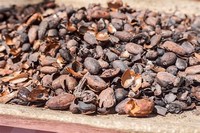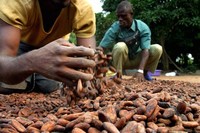Facts about Cocoa

The word cocoa also is used to refer to cocoa powder, the dry powder made by grinding cocoa seeds and removing the cocoa butter from the dark, bitter cocoa solids.

The ingestion of flavonol-rich cocoa is associated with acute elevation of circulating Nitrous oxide, enhanced flow-mediated vasodilation, and augmented microcirculation.

Each seed contains a significant amount of fat (40–50 percent as cocoa butter).

Cocoa is the dried and partially fermented fatty seed of the cacao tree from which chocolate is made.

The Netherlands is the leading cocoa processing country, followed by the United States.

When the pods ripen, they are harvested from the trunks and branches of the cocoa tree with a curved knife on a long pole.

Chocolate and cocoa contain a high level of flavonoids, specifically epicatechin, which may have beneficial cardiovascular effects on health.

Regular (nonalkalized) cocoa is acidic, so when added to an alkaline ingredient like baking soda, the two react and leave a byproduct.

Cocoa beans, Cocoa butter, and cocoa powder are traded on two world exchanges: London and New York.

The fermented pulp trickles away, leaving cocoa seeds behind to be collected.

Cocoa contains high levels of flavanoids that have been linked to cardiovascular health benefits.

Adding an alkali produces Dutch process cocoa powder, which is less acidic, darker, and more mellow in flavor than what is generally available in most of the world.

The futures price of cocoa butter and cocoa powder is determined by multiplying the bean price by a ratio.

The London market is based on West African cocoa and New York on cocoa predominantly from South East Asia.

To make 1 kilogram (2.2 pounds) of chocolate, about 300 to 600 beans are processed, depending on the desired cocoa content.

The liquified pulp is used by some cocoa producing countries to distill alcoholic spirits.

Prolonged intake of flavonol-rich cocoa has been linked to cardiovascular health benefits, though it should be noted that this refers to plain cocoa.

Dark chocolate's addition of whole milk reduces the overall cocoa content per ounce while increasing saturated fat levels, possibly negating some of cocoa's heart-healthy potential benefits.

A cocoa pod has a rough leathery rind about 3 cm thick (this varies with the origin and variety of pod).

The harvested pods are opened with a machete, the pulp and cocoa seeds are removed and the rind is discarded.





